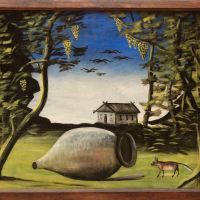Antidote Art #1: Puppetry As Antidote Art
I need to say something about puppets.
I need to communicate something here, in this manner, about puppetry and it’s relationship to the world we are moving into. The problem isn’t that I don’t know what to say; the problem is that there is too much to unravel, too many long thoughts, involved histories, autopsies of other cultural manifestations. I’m also not quite sure who the reader of this little missive will be. I have to assume that most of the people who will read this, at this moment in 2011, have little or no interest in the subject. Then there are those who may find this introductory little essay who might have a professional interest. Yet I believe what I have to say can span the gap.
For most, certainly most Americans at any rate, the mention of puppets will immediately start hitting exactly the buttons I do not wish to hit. So let me just get this off my chest now and we’ll take it as given. Muppets are indeed puppets, but the world of puppetry is so much wider, so much deeper that I have to state from the beginning “Don’t think of puppets merely as Muppets.” Secondly, in a similar vein, puppets are not a children’s medium. (Any serious puppeteer actually reading this at the moment will wonder why I’m restating the obvious.) I would say that, without a doubt, for the vast majority of folks, puppets are for kids. To which all I can say to that is keep reading. Thirdly, puppets aren’t simply a quaint folk art, though they have a fascinating history. And finally for my lefty friends, puppets aren’t just for protest marches: cardboard turtles and political effigies. Puppets aren’t even exclusively humorous and ironic.
What then am I talking about? Punch? Absolutely. Guignol? Certainment. Shakespeare performed with marionettes? Often. Faust? Don Juan? Mozart operas? Nativity plays? Ballets? Modernist theatre? Puppet films? Seven times yes! Performed in little booths? In traditional theatres? In parades? In barns? In fields? In water? In the dark? Seven more times yes! They can make you laugh, but you knew that. They can make you cry. They can even frighten you. And they certainly can even make you think. They can defy truth, religion and God, because they can also speak of truth,
religion, God. Unlike actors they are perfect as abstractions, as personifications, as pageantry, as philosophy. But like actors they can be imbued with movement, with character and with a voice. Puppetry is an art that is only just now coming into it’s own.
And puppets can even enter into the historical realm. Consider puppetry in the Czech Republic: Folk and church puppets certainly existed there during the Middle Ages, but the proof is scanty. Serious puppetry was introduced sometime in the Baroque Era through English, Italian and German itinerant companies. Marionettes performed versions of Marlowe, Shakespeare and even Molière. The Czechs took to marionettes with great enthusiasm and soon began to produce their own little puppet plays as well as this classic repertoire. Marlowe’s Faust became a traditional favorite, likewise Don Juan (Don Giovanni) and biblical themes. And after the Battle of White Mountain in 1622, which resulted in Germanic language domination by the Austrians, puppetry became one of the few cultural venues allowed to smuggle in the forbidden Czech language. One of the characters inherited by Czechs was the Pulcinella, Punch, Kasperl puppet who was christened Kaspárek in the Czech lands. This loudmouthed creature was like an unhinged court jester who was by the late 19th Century, saying some awfully pungent things about the Czechs Austro-Hungarian overlords. One puppeteer claimed that the remarks were not his fault, but the puppet’s. But this was only the beginning.
Actually, by the mid- 19th Century, puppetry was beginning to take a familiar road in the Czech Republic, the road that leads to the quarantine of childhood. Yet by the turn of the 20th Century Czech puppetry was on a new track that would intensify itself through the darker days to come. Theatrical artists were beginning to discover the lowly hand puppet and shadow puppets had arrived with more visibility. And with a revival of the Czech language came a printing of several classic puppet plays. The first congress of Czech puppeteers was held in 1903, which would eventually pave the way for the formation of UNIMA (Union Internationale de la Marionette), the international puppetry organization. In 1912 the world’s oldest puppetry magazine, Cesky Loutkár, (The Czech Puppeteer) entered circulation. It continues today as Loutkár. Also in the early part of the 20th Century, puppets began to be discovered by modernists of various stripes. This just scratches the surface though. The real value of puppetry in the old Czechoslovakia can be seen by what happened during the Second World War.
This is a lecture on the same topic from a couple years later.
The Nazis occupied not only the Sudetenland but also all of the Czech lands during the war. The Czechs did not welcome the beast however. And one thing they had working for them was the impenetrability of the Czech language. Also the serious Germans did not at first fully grasp the place of puppetry in helping to preserve the language in the face of a previous Germanic Austrian suppression. They hadn’t done any basic research on how many puppet theatres there were in this small country in, say, 1936: 1,357. Nor how many puppet plays had been performed that year: 10,000. Nor did they grasp the significance of the rebellious Kaspárek in thumbing his Bohemian nose at the Austro-Hungarian Empire.
Under the watchful eye of the Nazis Czech puppeteers found surreptitious ways to perform suspect material. The SS began the elimination of some puppet theatres in 1938.. By March of 1939 it was clear to the Nazis that puppet performances were clearly a danger to the propaganda of the Third Reich. They shut down Loutkár and the Sokol puppet institution. Underground anti-fascist puppet plays were held even when all Czech cultural manifestations were for a time halted. Meanwhile the plays of Josef Skupa, the greatest living Czech puppeteer, the inventor of the beloved Spejbel and Hurvinek, were presenting challenging allegorical works for their adult programs. These plays did not catch the attention of the SS overlords immediately. In fact they tried to use Skupa’s fame as a propaganda tool by claiming, falsely, that Skupa had performed for the Nazis in Germany.
But as the war entered it’s feverish final phase Czech puppeteers were snagged in the nets of the Germans. Many were tortured, imprisoned, tossed into concentration camps. Professor Skupa was thrown into a jail in Dresden near the end of the war. And in a supreme irony, he was able to escape when the murderous Allied bombs destroyed not only the city but the prison that held him. All in all, however, over one hundred Czech puppeteers were martyred at the hands of the Nazis. And yet in one of the most fascinating chapters of this strange story Czech prisoners at the Terezín and Ravenbrück concentration camps made miraculous puppet shows out of rags to entertain their fellow doomed inmates.
This, obviously, is something quite different from the cute childish figures that linger in the common perception of what a puppet can do. And just as plainly, these puppeteers did not conform to the happy-go-lucky stereotypes that again form the popular imagination of what puppetry can be. These were not simply puppeteers as counter-propagandists. This was puppetry as a courageous truth telling art.
And we haven’t even gotten to communist era yet! Great figures like the puppet filmmakers Jiri Trnka and Jan Svankmajer both ran afoul of the censors with their allegorical works. And puppeteers learned to speak with subtlety so that scripts might be approved, while the imagery might speak a different message entirely. And even after the Velvet Revolution puppetry still speaks in questioning tones about the value of all of that materialistic cash being injected into the Czech economy at the expense of the soul of the nation.
In short, in the Czech lands we have a clear case where puppetry was never simply reduced to a kiddie cute definition. But what is the value of even this sort of puppetry in this 21st Century hi-tech virtually networked media saturated world?
(See part two.)
Byrne Power
Haines Alaska
3/2/11
Most of the Czech puppet history is found in Dr. Jan Malik’s book Puppetry in Czechoslovakia (Orbis, Prague 1948) and The World of Puppets Yesterday and Today (Museum of Puppetry, Chrudim, Czech Republic 1997) – both highly recommended.












